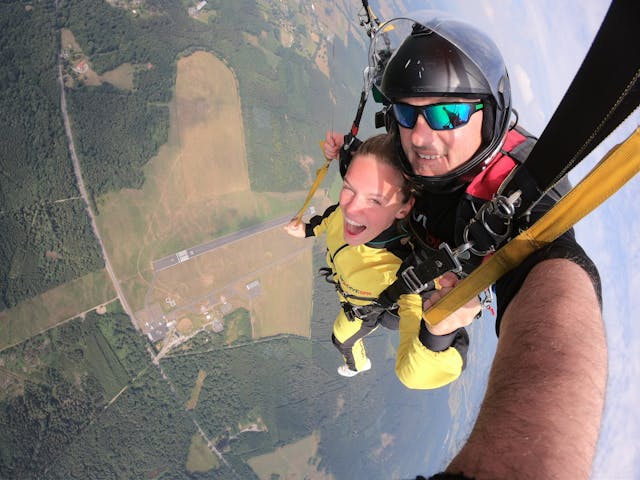How old do you have to be to skydive: Discover age limits, laws, and what teens and parents need to know before taking the leap.
Let’s be honest: few experiences match the rush of skydiving. It’s the ultimate plunge, the moment you defy gravity and surrender to the wind. But if you’re under 18 and eyeing the clouds, one question stops everything in its tracks: how old do you have to be to skydive?
The answer is simple on the surface, but surprisingly complex when you zoom in by country, jump type, and legal liability. Let’s unpack the laws, the logic, and the options.
What You'll Discover:
Minimum Age to Skydive in the United States
If you’re planning to jump from a plane in the U.S, here’s the cold, hard truth:
You must be at least 18 years old. No exceptions. Not even with parental consent.
That’s the Federal Aviation Administration (FAA)-backed standard, and all USPA (United States Parachute Association) affiliated dropzones strictly follow it. Even if your mom says “yes” and you bring a signed waiver, a reputable center will still turn you away if you’re under 18.
Why? Liability. Tandem skydiving involves intense legal and physical responsibility, and minors can’t sign binding contracts in the U.S.
What If You’re Under 18 and Still Want to Skydive?
You’ve got options. But they’re limited, and international.
Several countries allow younger jumpers under specific conditions. You may just need a passport and parental support.
Countries Where You Can Skydive Under 18
| Country | Minimum Age | Requirements |
| Australia | 16 | Parental consent required |
| New Zealand | 16 | Parental or guardian approval |
| UK | 16 | Must bring a medical declaration form and parental consent |
| South Africa | 16 | Supervised jump with training |
| Canada | Varies by province (usually 16–18) | Parental consent mandatory |
| Dubai (UAE) | 18 | No exceptions |
So yes, if you’re 16 or 17 and can swing a family-approved skydiving vacation in New Zealand or Australia, your dream isn’t dead. It just has a timezone difference.
Why 18 Is the Gold Standard in the U.S.
Let’s dig into why the age limit is so strict in the States.
1. Legal Contracts
Skydiving involves waivers that protect the company from liability. Since minors can’t legally waive rights, most businesses won’t take the risk.
2. Physical Maturity
While 16- and 17-year-olds might physically handle a jump, instructors are trained to tandem with adult-size participants. Ensuring body weight, harness size, and mental readiness all align is easier when 18+ is the baseline.
3. Insurance Policies
Most skydiving centers are covered under insurance that requires all jumpers to be of legal age. Accepting a minor voids that coverage.
4. Standardization
Using 18 as the minimum makes for consistent, enforceable rules across thousands of U.S. dropzones.
Can You Skydive Solo as a Teen?
In the U.S, no. In most other countries, not without intensive training. Solo jumping requires an AFF (Accelerated Freefall) certification, which takes several days, hours of ground school, and repeated supervised jumps. And again, the age limit for AFF still usually starts at 16–18 depending on location and dropzone.
How to Prepare for Your First Jump (When You Hit the Age)
Turning 18 soon and ready to go? Here’s how to prepare for that once-in-a-lifetime dive:
Step 1: Choose a Reputable Dropzone
Use the USPA Dropzone Locator to find certified facilities. Look for experienced instructors, updated gear, and stellar reviews.
Step 2: Eat Light, Dress Right
Go for a light meal, no greasy burgers or empty stomachs. Dress in athletic layers and lace-up sneakers.
Step 3: Bring Legal ID
No ID = No jump. They’ll need proof you’re legally 18.
Step 4: Be Ready Mentally
Nervousness is normal. But if you’re panicking or freezing, instructors may delay your jump. Talk to them, they’re trained to coach you through the jitters.
Parents: Should You Let Your Teen Skydive Abroad?
Let’s flip the script. If you’re the parent of a thrill-seeking teen, and they’re begging to skydive in Australia or Canada, what should you consider?
Pros:
- You’re giving them a memory for life.
- It can be a powerful confidence booster.
- It’s a chance to bond over something extreme and unforgettable.
Cons:
- Skydiving always carries risk.
- International liability and medical systems may complicate issues.
- If something goes wrong, you’re dealing with foreign laws.
If your child is physically healthy, emotionally ready, and the center has a strong safety record, the risk is arguably lower than daily driving or contact sports.
Skydiving Alternatives for Younger Thrill Seekers
Too young to jump out of a plane? No problem. There are ways to simulate the experience and build toward the real deal:
1. Indoor Skydiving (iFLY & others)
Minimum age: often 3 years old. Great for learning body positioning, experiencing freefall simulation, and building confidence.
2. Paragliding Tandem Flights
Some countries allow teens as young as 12–14 to paraglide with an instructor.
3. Adventure Courses
Think zip-lines, climbing towers, or vertical wind tunnels, they prime the body for real aerial movement.
4. Flight Training
Glider schools sometimes accept teens as young as 14. While it’s not skydiving, flying a plane solo at 16? Still badass.
What About the Maximum Age to Skydive?
Let’s bust a myth: there’s no legal upper age limit to skydive.
If you’re 85 and fit, you can jump. The key is health, not age. Many first-time jumpers are seniors crossing off bucket list items, with proper health clearance and medical forms, they’re as eligible as anyone else.
Skydiving Rules by Type of Jump
Let’s clarify how different jump types affect age requirements:
| Jump Type | Minimum Age (US) | Other Notes |
| Tandem Jump | 18 | Most popular, easiest option |
| Solo AFF | 18 | Requires training, multiple jumps |
| Static Line | 18 | Rare in civilian life, mostly military |
| BASE Jumping | No legal minimum | Extremely dangerous, not regulated |
BASE jumping and wingsuiting are not recommended for teens, or even most adults.
Key Takings
- In the U.S, you must be 18 years old to skydive, no exceptions, even with parental consent.
- Some countries like Australia, New Zealand, and the UK allow jumps at 16+ with guardian approval.
- The age limit is tied to legal contracts, insurance, physical safety, and standardization.
- Younger thrill-seekers can try indoor skydiving or paragliding until they’re of legal age.
- There’s no maximum age for skydiving, fitness matters more than numbers.
- If you’re planning to jump at 18, start preparing early: mentally, physically, and logistically.
- Skydiving is more than a bucket-list item, it’s a profound and transformational experience, best enjoyed when you’re truly ready for it.





